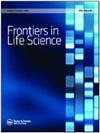从巴基斯坦旁遮普上游淡水和废水中分离的新型微藻的菌株选择、生长效率和生物量特征
Q1 Biochemistry, Genetics and Molecular Biology
引用次数: 26
摘要
摘要本研究旨在利用较便宜的培养基选择高脂含量的快速生长微藻,以降低藻类生物量生产的成本。从40个不同地点的新鲜和废水体中收集了样本。基于形态差异,选择废水中的2种微藻(SSG和SA)和淡水生境中的3种微藻(OP、DFM和JRC)进行进一步表征。在本地设计的光生物反应器中,OP、DFM、JRC、SA和SSG的比生长率(g Day−1 L−1)分别为0.614、0.638、0.734、1.06和1.02,而倍增时间(Td)分别为39.30、36.48、22.08、12.24和12.98 h。5种微藻在pH 6.0 ~ 9.0范围内均有较好的生长,在pH 7.5 ~ 8.5范围内活性最高。OP、DFM和JRC的脂肪含量为27%,而SSG和SA的脂肪含量为39%。基于18S rRNA基因序列的系统发育分析表明,所研究的微藻菌株可能是新种。本文章由计算机程序翻译,如有差异,请以英文原文为准。
Strain selection, growth productivity and biomass characterization of novel microalgae isolated from fresh and wastewaters of upper Punjab, Pakistan
ABSTRACT The present study was focussed on selection of fast-growing microalgae with higher lipid content using cheaper growth media, aimed to reduce the cost of algal biomass production. Samples were collected from 40 different sites from fresh and wastewater bodies. Based on morphological differences, two microalgae (SSG and SA) from wastewater and three (OP, DFM and JRC) from fresh water habitat were selected for further characterization. The specific growth rates (g Day −1 L−1) of the OP, DFM, JRC, SA and SSG were found to be 0.614, 0.638, 0.734, 1.06 and 1.02, respectively, whereas the doubling time (Td) was shown to be as 39.30, 36.48, 22.08, 12.24 and 12.98 h, respectively, when cultured without controlled temperature and CO2 supply, in a locally designed photobioreactor. All five microalgae shown considerable growth at a range of pH 6.0–9.0 with a peak activity within pH range 7.5–8.5. The OP, DFM and JRC contained 27%, whereas SSG and SA shown 39% lipid content. The phylogenetic analyses based on the 18S rRNA gene sequence have shown that studied microalgal strains may be novel species.
求助全文
通过发布文献求助,成功后即可免费获取论文全文。
去求助
来源期刊

Frontiers in Life Science
MULTIDISCIPLINARY SCIENCES-
CiteScore
5.50
自引率
0.00%
发文量
0
期刊介绍:
Frontiers in Life Science publishes high quality and innovative research at the frontier of biology with an emphasis on interdisciplinary research. We particularly encourage manuscripts that lie at the interface of the life sciences and either the more quantitative sciences (including chemistry, physics, mathematics, and informatics) or the social sciences (philosophy, anthropology, sociology and epistemology). We believe that these various disciplines can all contribute to biological research and provide original insights to the most recurrent questions.
 求助内容:
求助内容: 应助结果提醒方式:
应助结果提醒方式:


